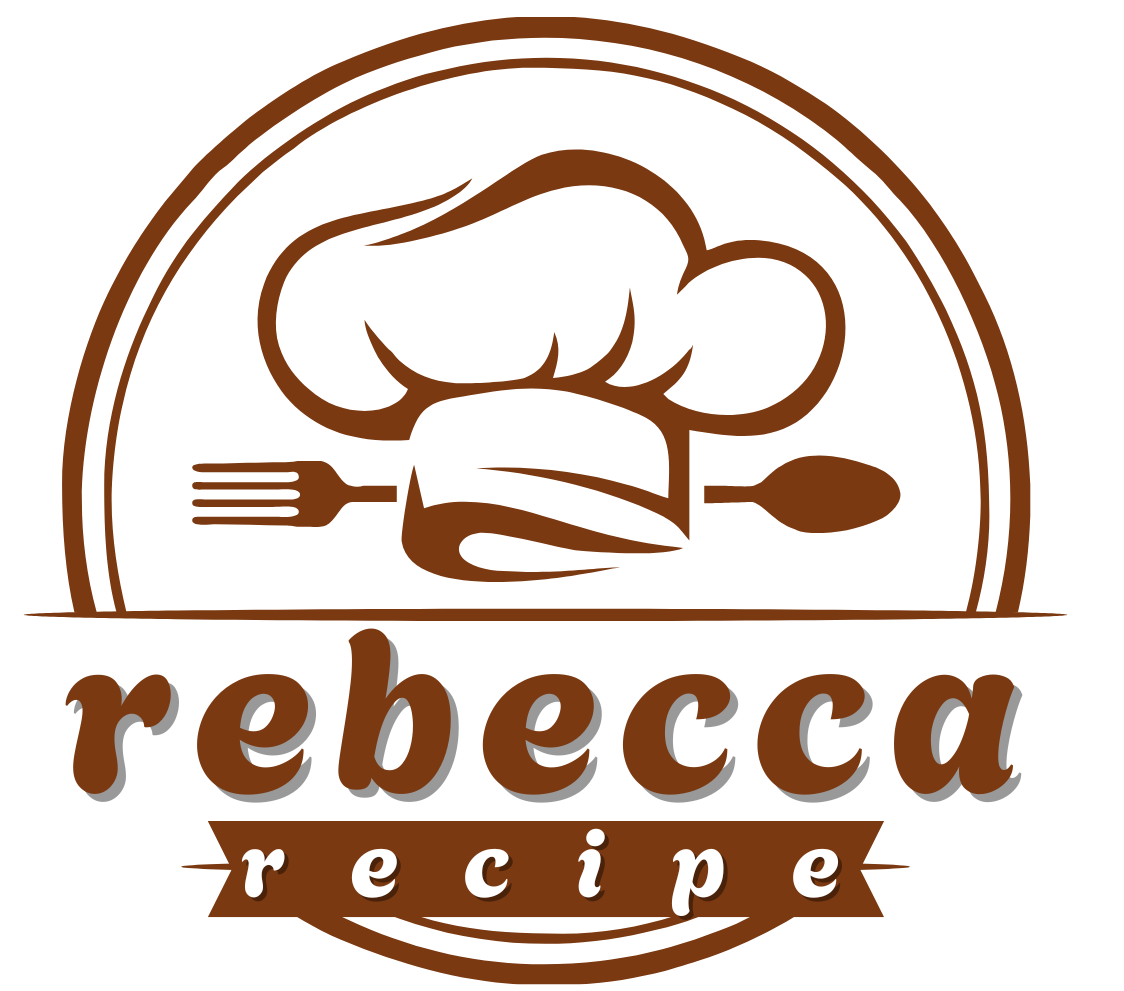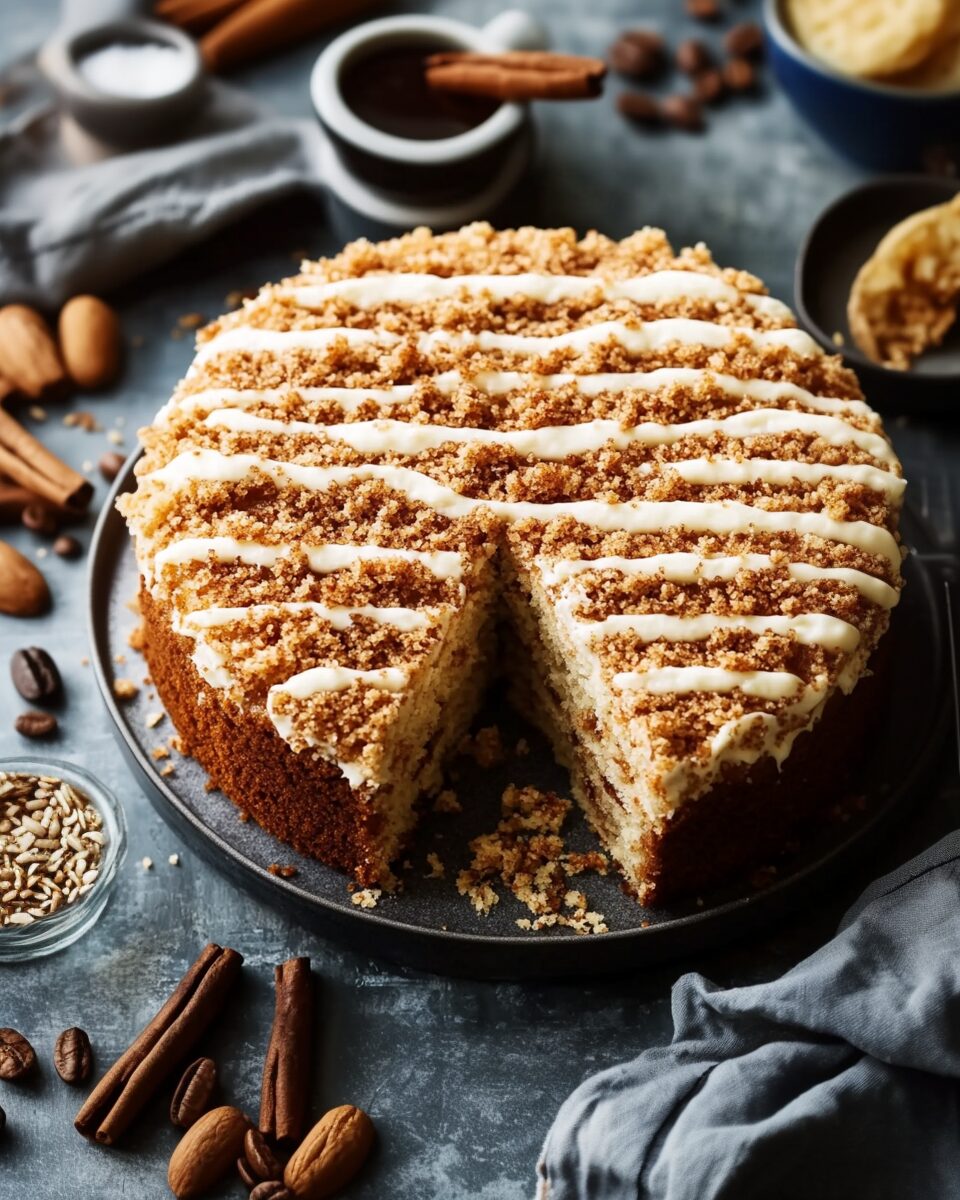This classic coffee cake is a moist, buttery delight featuring a sweet cinnamon streusel ribbon in the center and topped with a crumbly streusel. Perfect for breakfast or dessert, it pairs wonderfully with a cup of coffee for an early morning treat or an afternoon pick-me-up.
Full Recipe:
Ingredients
-
2 cups all-purpose flour
-
1 teaspoon baking powder
-
½ teaspoon baking soda
-
½ teaspoon salt
-
1 tablespoon melted butter
-
1 egg (room temperature)
-
1½ cups buttermilk (room temperature)
Streusel Filling:
-
3 tablespoons softened butter
-
1 tablespoon cinnamon
-
½ cup all-purpose flour
-
½ cup brown sugar
Crumb Topping:
-
½ cup firmly packed light brown sugar
-
½ cup all-purpose flour
-
½ tablespoon cinnamon
-
¼ cup butter, cubed
-
⅛ teaspoon salt
Drizzle Topping:
-
½ cup powdered sugar
-
2½ teaspoons milk
Directions
-
Preheat the oven to 375°F. Grease a 9×9-inch baking dish with 2-inch sides. Optionally, line the dish with parchment paper.
-
In a large bowl, combine the flour, baking powder, baking soda, and salt.
-
In a medium bowl, mix the melted butter, egg, and buttermilk.
-
Add the wet ingredients to the dry ingredients, stirring until just combined.
-
Pour half of the batter into the prepared baking dish.
Streusel Filling: 6. In a small bowl, mix together the softened butter, cinnamon, flour, and brown sugar until crumbly. 7. Sprinkle the streusel filling evenly over the batter in the dish. 8. Spread the remaining batter over the streusel layer.
Crumb Topping: 9. In a small bowl, combine the cubed butter, brown sugar, flour, cinnamon, and salt, mixing until crumbly. 10. Sprinkle the crumb topping evenly over the top layer of batter.
-
Bake for 30 to 40 minutes, or until a toothpick inserted into the center comes out clean.
-
Allow the cake to cool in the pan on a wire rack for 15 minutes. Then, lift the cake out of the pan and let it cool completely.
Drizzle Topping: 13. In a small bowl, mix the powdered sugar with 2 to 3 teaspoons of milk until smooth. Adjust the milk quantity to achieve the desired consistency. 14. Drizzle the glaze over the cooled cake before serving.
Nutritional Facts
Per serving (assuming 12 servings):
-
Calories: 292
-
Carbohydrates: 49g
-
Protein: 5g
-
Fat: 9g
-
Saturated Fat: 5g
-
Polyunsaturated Fat: 1g
-
Monounsaturated Fat: 2g
-
Trans Fat: 0.4g
-
-
Cholesterol: 33mg
-
Sodium: 311mg
-
Potassium: 116mg
-
Fiber: 1g
-
Sugar: 24g
-
Vitamin A: 245IU
-
Vitamin C: 0.3mg
-
Calcium: 90mg
-
Iron: 2mg
The Classic Coffee Cake Recipe: A Perfect Blend of Flavor and Texture
Coffee cake is often characterized by its rich, buttery flavor and moist texture. It typically features a tender crumb, sometimes with a swirl of cinnamon sugar or a streusel topping, adding an extra layer of sweetness and crunch. The classic version of coffee cake includes ingredients like flour, sugar, eggs, butter, and buttermilk, all of which work together to create a rich, flavorful base. But what sets coffee cake apart from other cakes is the addition of a streusel topping, which is made from a mixture of butter, brown sugar, flour, and cinnamon. This topping provides a perfect contrast to the soft, moist cake underneath.
One of the most distinctive features of coffee cake is its simplicity. The cake itself is not overly sweet, allowing the flavors of the butter, cinnamon, and other ingredients to shine through. The streusel topping adds a delightful crunch and sweetness that elevates the entire experience. Unlike more elaborate desserts, coffee cake doesn’t require intricate techniques or hard-to-find ingredients, making it an accessible and approachable dessert for bakers of all skill levels.
The History Behind Coffee Cake
The origins of coffee cake can be traced back to Europe, particularly Germany and Scandinavia, where cakes were traditionally served alongside coffee during social gatherings. The concept of pairing coffee with cake has existed for centuries, as coffee houses in European countries became hubs for social interaction. Early versions of coffee cakes were often simple, lightly sweetened cakes made with ingredients that were readily available, such as flour, butter, and sugar. These cakes were meant to complement the bitterness of coffee, balancing out the flavor.
As coffee became more widespread, so did the tradition of serving it with cake. By the 18th century, coffee cake recipes began to evolve, and different cultures added their own unique twists. In Germany, for example, coffee cake was often enriched with fruit, such as apples or berries, while in Scandinavian countries, it was common to include nuts or spices like cardamom.
In the United States, coffee cake gained popularity in the 19th century, particularly in the Midwest, where it became a staple at family gatherings and holiday celebrations. It was often served as part of a larger spread at brunches or potlucks. Over time, American versions of coffee cake became more diverse, with variations ranging from the addition of cream cheese or fruit to the incorporation of nuts or chocolate chips.
Why Coffee Cake is Perfect for Any Occasion
Coffee cake is a versatile dessert that fits perfectly into a variety of occasions. Its mild sweetness and tender texture make it suitable for breakfast or brunch, where it can be paired with a steaming cup of coffee or tea. Its slightly crumbly texture and hint of cinnamon make it the ideal accompaniment to a warm beverage, offering a comforting experience that feels cozy and indulgent.
Beyond breakfast and brunch, coffee cake is also a great choice for afternoon tea or casual gatherings with friends and family. It can be served as part of a dessert table for a holiday celebration or special occasion, and its appealing appearance makes it a great centerpiece. Whether it’s a casual get-together or a formal event, coffee cake never fails to impress guests with its delicious flavor and satisfying texture.
The simplicity of coffee cake also makes it an ideal option for home bakers who want to create a delicious, homemade treat without the need for complicated techniques or exotic ingredients. The cake can be made in a single pan, with the streusel topping being added right before baking, allowing for an easy, no-fuss preparation. Furthermore, it can be customized to suit individual preferences, whether by adding a glaze, fruit filling, or additional spices. The flexibility of coffee cake makes it a reliable dessert option for nearly any occasion.
Customizing Your Coffee Cake
One of the best things about coffee cake is how easily it can be customized. While the classic version features a cinnamon-streusel topping, there are countless variations that you can experiment with to make the cake your own. Some popular options include adding fruits like apples, blueberries, or raspberries to the batter or the topping for a burst of fresh flavor. This not only adds sweetness but also creates a beautiful, colorful presentation.
For those who prefer a richer flavor, you can incorporate a cream cheese filling into the cake, creating a luscious, tangy contrast to the sweetness of the streusel. Swirling a cream cheese mixture into the batter adds moisture and creaminess, giving the cake an indulgent twist.
If you want to add a bit more texture to your coffee cake, consider including nuts like walnuts or pecans in the streusel topping. These nuts add a crunchy element that pairs beautifully with the soft, buttery cake. You can also experiment with different spices, such as nutmeg or cardamom, to infuse your coffee cake with unique flavors.
For a more decadent version, some bakers choose to drizzle a glaze over the cake once it has cooled. This glaze, typically made from powdered sugar and milk, adds a touch of sweetness and shine, making the cake look even more inviting. Alternatively, a chocolate drizzle or ganache can be used for a more indulgent treat.
Tips for Making the Perfect Coffee Cake
Making the perfect coffee cake requires attention to detail and a few key techniques to ensure that it turns out light, moist, and flavorful. Here are some tips to help you achieve the best results:
-
Use room temperature ingredients: For the best texture, make sure your butter, eggs, and buttermilk are at room temperature before you begin mixing the batter. This ensures that they incorporate smoothly and create a uniform texture.
-
Don’t overmix the batter: When combining the dry and wet ingredients, mix until just combined. Overmixing can result in a dense, tough cake, so it’s important to stir gently and avoid overworking the batter.
-
Preheat the oven: Always preheat your oven before baking your coffee cake. This helps the cake cook evenly and rise properly.
-
Check for doneness: Coffee cake is done when a toothpick inserted into the center comes out clean or with just a few moist crumbs attached. Avoid opening the oven door too frequently while baking, as this can cause the cake to sink.
-
Allow it to cool: Let the cake cool for a few minutes in the pan before transferring it to a wire rack. This will prevent the cake from falling apart.
-
Experiment with toppings: Whether you prefer a classic cinnamon streusel topping or want to try adding fruit, nuts, or a glaze, don’t be afraid to get creative with your coffee cake toppings.
Conclusion: The Enduring Appeal of Coffee Cake
Coffee cake is a beloved dessert that continues to capture the hearts of bakers and dessert lovers alike. Its simplicity, versatility, and comforting flavor make it a staple at any occasion, whether it’s a casual breakfast, a festive brunch, or a celebratory gathering. The ability to customize coffee cake with various fillings, toppings, and flavors ensures that it remains a timeless favorite for all generations.






